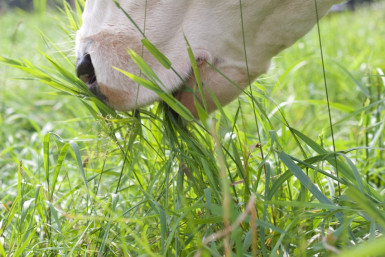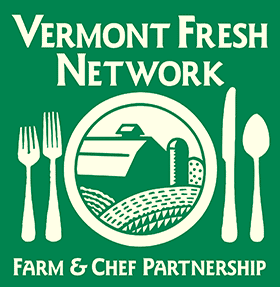Food Labels - Grassfed
 August 20, 2018
August 20, 2018
This is the third installment in a series taking a closer look at some common food labels. For a quick snapshot of common labels found in Vermont look at our labeling guide. This information is part of VFN's work to improve communications between Vermont chefs and Vermont food producers, including through our updated and expanded member-to-member business directory (if you're a current VFN member, you can login now to view the directory and update your listing - don't remember your login info? Email info@vermontfresh.net).
If you really get into the meaning of food labels (which some of us do), then “grassfed” is the case study for you. It presents a whole host of major food system nuances and challenges right in one package, and offers a strong cautionary tale in why it’s often best practice to combine a label like “grassfed” with a local focus, instead of trusting a global marketplace’s claims.
This story all begins with the increasing value of a grassfed label on meat, and beef in particular. The retail value per pound is often twice, sometimes three times as much, as conventional (the USDA released monthly reports). Farmers need that premium because it costs much more to produce grassfed meat - true, you don’t have to buy in grain, but animals require significantly more time, labor, and land to be fully fattened, and the final animal is smaller. Consumers pay the premiums, though, in 2017 the Stone Barns Center released a report showing growth in grassfed sales from $17 million in 2012 to $272 million in 2016.
Grassfed meat’s popularity comes from two of the big consumer concerns - health and environment.
On the health side of the equation, trendy diets like Paleo that advocate grassfed meat have put it on the national consumer radar. Grassfed tends to mean lower fat, healthier types of fat, and more antioxidants and vitamins.
Environmentally, grassfed meat uses pasture covered in perennial grasses that hold soil in place, sequester carbon, and improve structure for water retention. Grass-based diets for cattle reduce the run off of nutrients like nitrogen and phosphorus both from improved soil structure and how the manure is managed, as well as potentially reducing the amount of those nutrients imported to the watershed via grain-based feed. The impact of grassfed meat compared to a non-animal based diet is a matter of debate, but compared to other forms of meat production it can have an ecological leg up when managed properly and undertaken in a place like Vermont that is quite good at growing grass on existing farmland. Globally, however, deforestation to provide land for grassfed cattle, often followed by overgrazing, can eliminate many environmental benefits.
So, how do you find the meat that provides the most benefit? Practically speaking, for Vermonters, it’s local grassfed meat. We’re obviously biased in that regard, we mean it though, read on for why.
You don’t have to get far into researching “grassfed” to turn up a host of challenges. Much of the confusion comes from the national level. Until recently, the USDA had a legal definition for grassfed ruminant animals. This definition required that, for grassfed claims, the animal be raised only on grass or grass-based feed after it stopped drinking its mother’s milk and that it have continuous access to pasture during the growing season. However, the USDA rolled back its certification program and withdrew the rules on the grassfed claim in 2016, stating that they were unable to provide reliable verification. USDA still has some remnants of certification for very small operations but it is all desk certification (ie no inspections, just review of paperwork). Also, remember that grassfed meat will often still carry a USDA seal, because it has been processed according at a USDA-inspected plant (not because USDA has necessarily endorsed a “grassfed” label).
In the absence of USDA assistance, third-party certifications fill the gap. The most common option is American Grassfed for meat, dairy, and pasture pork. A new option in Vermont that may gain popularity is to add grassfed certification onto organic certification. Even before the USDA’s program ended, alternative certifications offered standards that went beyond the USDA minimums. The American Grassfed Association specifically adds animal health and welfare criteria to its definition, NOFA-VT adds organic standards, and other options also exist. A Greener World (AGW), for example, also inspects best environmental practices in pasture management and the Savory Institute is planning to offer a certification that considers holistic pasture management. We also now have the emergence of private label grassfed protocols, where businesses aggregate cattle from locations they have verified as meeting their grassfed standards - for example Big Picture Beef, Thousand Hills, and Walden Local.
One advantage of the businesses and co-operatives that work with many small farmers to follow their sourcing protocols is that they may be best equipped deal with an ongoing issue in grassfed meat - chain of custody of the animal. Some farms do manage a cow from birth to death, but common practice is to bring in feeder calves and eventually bring the cattle elsewhere for slaughter and processing. In Vermont, where it is particularly difficult to fully fatten cattle on grass, there may also be another intermediary who finishes the beef before slaughter. Different grassfed protocols have different ways of verifying that the farm knows how an animal has been raised through its life.
An even bigger chain of custody issue has become very contentious in recent years, after the Obama administration rolled back Country of Origin Labelling (COOL) rules. This change made it easy to label foreign beef as a USA product after being processed here (ground, cut into steaks, etc.) and the U.S. share of the grassfed meat market at home plummeted. As the New Food Economy explained in a July 2018 article, American grassfed meat consumers strongly prefer that USA label. Meanwhile, meat from places where grassfed is big business costs far less than domestic options. When a business can combine the economies of foreign production with a misleading domestic label, they’ve got an incredible advantage. Add in the environmental concerns listed of this piece and grassfed loses a lot of its luster in this context.
The American Grassfed Association and Organization for Competitive Markets has petitioned the USDA to reconsider its rules that allow for mislabeling of “domestic” meat, you can see their petition and argument for change here.
We’ll let you know if things change. In the meantime, knowing your grassfed meat producer, talking to them about pasture practices, and being prepared to pay a premium is likely the safest way to ensure you’re getting the full benefit of grassfed meat.
A significant amount of the information in this article was provided by Meghan Sheradin at the Vermont Grass Farmers Association - if you want to learn more about this method of production, check out their work at https://www.vtgrassfarmers.org/


